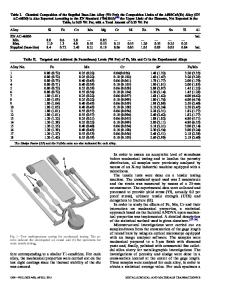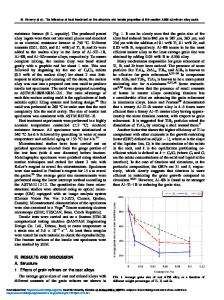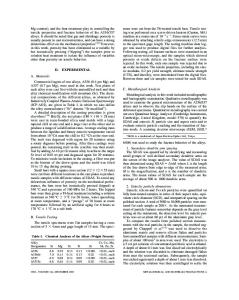The influence of biaxial prestrain on the tensile properties of three aluminum alloys
- PDF / 282,108 Bytes
- 4 Pages / 612 x 792 pts (letter) Page_size
- 97 Downloads / 334 Views
T H E p r e v i o u s p a p e r I d e a l t with the t e n s i l e d e f o r m a tion of s h e e t s p e c i m e n s a f t e r t h e y w e r e a x i a l l y p r e s t r a i n e d in a d i r e c t i o n 90 deg to the f i n a l t e s t i n g d i r e c t i o n . P r e v i o u s l y p u b l i s h e d r e s u l t s on the two s t a g e d e f o r m a t i o n of an a l u m i n u m k i l l e d s t e e l in both t e n s i l e t e n s i l e 2 and b i a x i a l - t e n s i l e 3 m o d e s have shown that i n s t a b i l i t i e s d u r i n g the s e c o n d d e f o r m a t i o n s t a g e i n v a r i a b l y a p p e a r a f t e r a p p r o x i m a t e l y 10 pet e f f e c t i v e p r e s t r a i n . The a i m of the p r e s e n t w o r k i s to i n v e s t i g a t e the t e n s i l e p r o p e r t i e s of s e v e r a l a l u m i n u m a l l o y s which have b e e n p r e s t r a i n e d in p l a n a r b a l a n c e d b i a x i a l t e n s i o n .
E X P E R I M E N T A L PROCEDURE T h e m a t e r i a l s u s e d in t h i s i n v e s t i g a t i o n c o n s i s t e d of two c o m m e r c i a l a l l o y s ; AA3003-0, AA2036-T4, and one fine g r a i n e d e x p e r i m e n t a l a l l o y 4, X-96. T h e s e alloys were chosen because previous results 1 indic a t e d that t h e s e a l l o y s b e h a v e d d i f f e r e n t l y : the t e n s i l e d u c t i l i t y could d e c r e a s e (AA3003-0), r e m a i n the s a m e (AA2036-T4), o r i n c r e a s e (X-96) a s a function of o r t h o g o n a l t e n s i l e p r e s t r a i n . The s t a r t i n g m a t e r i a l s w e r e in the f o r m of 305 • 305 x 1 m m p r e g r i d d e d sheet. P l a n a r b i a x i a l s t r e t c h i n g was c a r r i e d out in the m a n n e r d e s c r i b e d by G h o s h and L a u k o n i s z T e n s i l e s p e c i m e n s having a gage length of 25.4 m m w e r e cut f r o m the c e n t r a l a r e a of e a c h p r e s t r a i n e d b l a n k at 0, 45, and 90 deg to the r o l l i n g d i r e c tion, and f i n a l l y t e s t e d to f a i l u r e at a c r o s s h e a d s p e e d of 5 m m / m i n . M e c h a n i c a l p r o p e r t i e s w e r e obtained t h r o u g h a c o m p u t e r i z e d t e s t i n g r o u t e while load p a t h s and R v a l u e s w e r e c a l c u l a t e d f r o m m e a s u r e m e n t s on t h r e e c e n t r a l l y l o c a t e d and a x i a l l y a l i g n e d 6.36 m m diam scribed circles.
RESULTS AND DISCUSSION
Figures I to 3 show the typical strain paths followed by alloys AA3003-0, AA2036-T4, and X-96. The plastic anisotropy ratio R(= dEw~dEt) was calculated from the straight line tensile portions of the strain paths using the formuia: R :-1/(1
+ ZXEa/AEw)
[1]
w h e r e },Ea/LXE,~ is the s l o p e of the t e n s i l e load path. D. J. LLOYD and H. SANG are Research Scientists, Aluminum Company of Canada, Kingston, Ontario, Canada. Manuscript submitted September 15, 1977. METALLURGICAL TRANSACTIONSA
T h e / ~ and AR v a l u e s w e r e o b t a i n e d b y e m p l o y i n g the usual expressions: -R : (R o
Data Loading...









